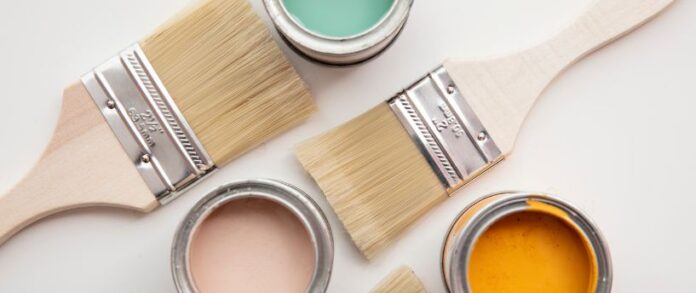After investing time and effort into painting a room, it’s essential to care for your newly painted surfaces to ensure they stay looking fresh and beautiful. Using Sherwin-Williams paints as a reference, this article will guide you through dry times, curing periods, and the best ways to clean and maintain various finishes. We’ll also include a comprehensive list of dry times for popular Sherwin-Williams paints and primers, ensuring you give your paint job the care it needs for a long-lasting, professional result.
Why Post-Paint Care is Critical
Taking care of freshly painted surfaces is just as important as the paint application itself. After you’ve completed your painting project, the paint needs time to dry and fully cure, which can take anywhere from a few hours to several weeks. If you don’t take care of your newly painted walls, you risk damaging the finish, causing discoloration, or creating a surface prone to peeling and cracking.
Paint may feel dry to the touch quickly, but it takes time to fully harden (cure), which is when the paint reaches its maximum durability. During this curing time, it’s important to avoid cleaning, scrubbing, or exposing the paint to moisture or heavy impacts. Sherwin-Williams offers several paint lines with different drying and curing times, which we’ll cover in more detail below.
Sherwin-Williams Product Dry Times & Curing Information
Interior Paints
- Sherwin-Williams SuperPaint®
- Dry Time to Touch: 1 hour
- Recoat Time: 4 hours
- Full Cure: 30 days
- Notes: This versatile paint is great for high-traffic areas, but it should be handled with care during the curing phase to avoid scuffs or scratches. Wait the full curing period before cleaning.
- Sherwin-Williams Duration Home®
- Dry Time to Touch: 1 hour
- Recoat Time: 2-4 hours
- Full Cure: 30 days
- Notes: This is a durable, washable paint perfect for bathrooms and kitchens due to its mildew-resistant formula. Avoid exposing freshly painted surfaces to high moisture or steam until fully cured.
- Sherwin-Williams Emerald®
- Dry Time to Touch: 2-4 hours
- Recoat Time: 4 hours
- Full Cure: 30 days
- Notes: Emerald is known for its superior washability and stain resistance, making it a great option for high-traffic areas. Like other paints, it requires the full curing time for optimal durability.
- Sherwin-Williams Cashmere®
- Dry Time to Touch: 1 hour
- Recoat Time: 4 hours
- Full Cure: 30 days
- Notes: Cashmere provides a smooth, luxurious finish that feels rich and velvety. During the curing phase, be gentle with the surface to prevent dents or smudges in this soft sheen finish.
Primers
- Sherwin-Williams Multi-Purpose Latex Primer
- Dry Time to Touch: 30 minutes
- Recoat Time: 1 hour
- Full Cure: 7 days
- Notes: A fast-drying, versatile primer that’s great for various surfaces. While it dries quickly, waiting the full cure period is essential for maximum adhesion and stain-blocking capabilities.
- Sherwin-Williams Extreme Block® Primer/Sealer
- Dry Time to Touch: 2 hours
- Recoat Time: 4 hours
- Full Cure: 14 days
- Notes: This primer is designed for tough stains like water damage or smoke. The longer dry and cure times help it properly seal in these stains, so allow it to cure completely before painting over.
- Sherwin-Williams ProMar® 200 Zero VOC Primer
- Dry Time to Touch: 1 hour
- Recoat Time: 4 hours
- Full Cure: 7 days
- Notes: A professional-grade primer suitable for both residential and commercial use. It dries quickly, but like all primers, the full cure time is critical for optimal performance.
- Sherwin-Williams Wall & Wood Primer
- Dry Time to Touch: 1 hour
- Recoat Time: 4 hours
- Full Cure: 14 days
- Notes: Perfect for walls and trim, this primer allows for smooth coverage and adhesion. Though it dries fast, allowing the full 14-day cure will help prevent peeling or cracking.
Dos and Don’ts for Newly Painted Surfaces
Dos:
- Allow Proper Ventilation: Proper airflow helps the paint cure faster and more evenly. Keep windows open or use fans for the first few days.
- Wait Before Cleaning: Although the paint might feel dry, wait at least 2 weeks before doing any light cleaning, and hold off on scrubbing for at least 30 days.
- Use Soft, Non-Abrasive Materials: Clean with a soft cloth or sponge using mild, non-abrasive cleaners during the first month.
Don’ts:
- Don’t Scrub Too Soon: Avoid using abrasive sponges or scrubbing the surface for at least 30 days to prevent dulling the paint or causing it to chip.
- Don’t Expose to Excessive Moisture: In areas like bathrooms or kitchens, avoid high humidity or water exposure until the paint has fully cured.
- Don’t Hang Anything Too Early: Avoid hanging pictures or placing furniture against walls until after the curing process to prevent indentations or paint damage.
Safe Cleaning Techniques for Newly Painted Surfaces
Cleaning your newly painted walls is an important part of maintaining their fresh look, but it must be done carefully, especially during the first few weeks. Here’s how to do it right:
- Wait At Least Two Weeks: For any touch-ups or light dusting, wait two weeks after painting. For more intensive cleaning, wait until the full 30 days curing period is complete.
- Gentle Cleaners: Use mild dish soap or diluted all-purpose cleaners like Simple Green for most surfaces.
- Soft Cloth or Sponge: Always use a damp (not soaking) cloth or soft sponge to avoid damaging the paint.
- Spot Cleaning: For specific stains, try gently spot-cleaning instead of scrubbing the entire wall.
- Rinse and Dry: After cleaning, wipe down the surface with a damp, clean cloth to remove any soap residue and dry with a soft towel to prevent streaking.
Troubleshooting Common Post-Paint Issues
Even with the best care, problems can sometimes arise. Here’s how to handle them:
- Streaks or Uneven Finish: Streaking often happens due to uneven drying or premature cleaning. Allow the surface to fully dry and cure before attempting any fixes. In some cases, a light sanding and touch-up might be necessary.
- Peeling or Cracking: If the paint begins to peel or crack, it could be a result of poor surface prep or moisture exposure. Scrape the damaged area, sand it smooth, apply primer if needed, and repaint.
- Scuff Marks: Scuffs are common, especially in high-traffic areas. Use a damp cloth and mild cleaner to gently wipe them away. For tougher marks, use a magic eraser, but be cautious as these can wear down the paint.
- Discoloration: Direct sunlight or high humidity can cause fading or discoloration. Using window treatments or UV-protective films can help prevent this, and a touch-up with the same paint can restore faded areas.
Recommended Cleaning Products and Tools for Paint Maintenance
Cleaning Products:
- Dawn Dish Soap: A mild, effective soap for everyday cleaning.
- Simple Green All-Purpose Cleaner: Diluted, it’s gentle and eco-friendly.
- Mrs. Meyer’s Multi-Surface Cleaner: A natural option, safe for painted surfaces.
- Magic Eraser (Use Sparingly): Great for scuffs, but it should be used lightly to avoid wearing down the paint.
Tools:
- Microfiber Cloths: Perfect for dusting without leaving behind lint.
- Soft Sponges: Use for wiping down larger areas or washing walls.
- Extendable Dusting Wand: Helps clean higher or hard-to-reach areas safely.
- Soft Towels: To dry surfaces after cleaning and avoid streaks or water spots.
Long-Term Paint Maintenance Tips
To keep your freshly painted surfaces looking their best for years to come, follow these long-term maintenance tips:
- Dust Regularly: Dust buildup can dull the finish over time. Wipe down walls every few weeks with a microfiber cloth.
- Avoid Sun Exposure: Direct sunlight can fade paint, so use curtains or blinds to reduce exposure, especially for dark colors.
- Touch-Ups: Keep extra paint for touch-ups in high-traffic areas like hallways, kitchens, or kids’ rooms. Touching up chips or scratches as they occur will help keep the finish looking fresh.
By following these care instructions and allowing the proper dry and cure times, you’ll protect your investment and keep your Sherwin-Williams painted surfaces looking flawless for years to come.









